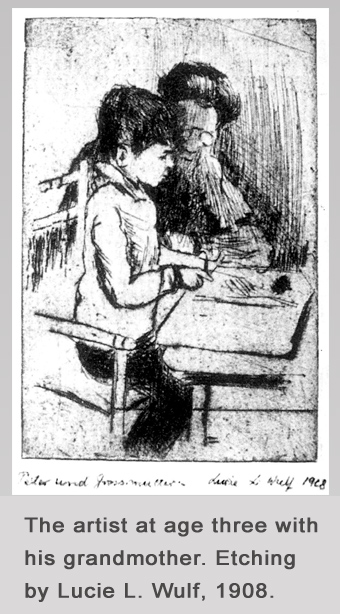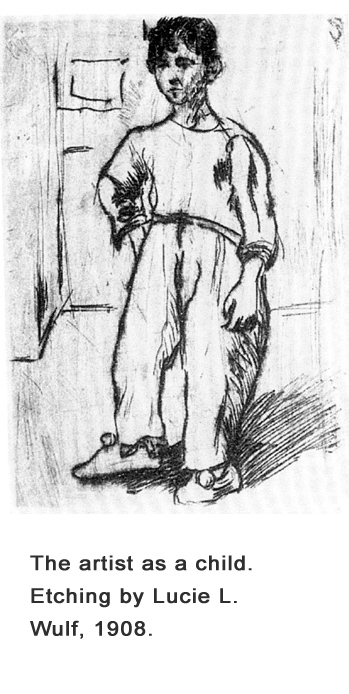 Peter Lipman-Wulf was a sculptor and printmaker born in 1905 in Berlin, Germany. His father, a well-known lawyer, and his mother, a prominent sculptor and portraitist, the family were assimilated Jews who converted to Protestantism. Raised in the culturally animated “salon” atmosphere of the early twentieth century, Peter decided at a very young age to become an artist. His mother cultivated these interests in him, and he was accepted into the avant-garde École d’humanité, a progressive school known as the Odenwaldschule, which centered around a humanistic approach to learning. Peter’s years there laid the ground work for a life-long passion for nature, and also forged in him the drive to learn the manual skills necessary to continue his studies of the arts.
Peter Lipman-Wulf was a sculptor and printmaker born in 1905 in Berlin, Germany. His father, a well-known lawyer, and his mother, a prominent sculptor and portraitist, the family were assimilated Jews who converted to Protestantism. Raised in the culturally animated “salon” atmosphere of the early twentieth century, Peter decided at a very young age to become an artist. His mother cultivated these interests in him, and he was accepted into the avant-garde École d’humanité, a progressive school known as the Odenwaldschule, which centered around a humanistic approach to learning. Peter’s years there laid the ground work for a life-long passion for nature, and also forged in him the drive to learn the manual skills necessary to continue his studies of the arts.
Looking for a solid foundation in the craft of wood carving, Peter was accepted at the age of 16 for a two-and-a-half year apprenticeship in Oberammergau, Germany, a Bavarian town famous for its re-enactments of the Passion Play
(http://www.passionplayoberammergau.com)
. He later completed his art education under the sculptor Ludwig Gies at the state Academy of Fine Arts in Berlin. There he was chosen to assume the position of Master Stone Carver and to succeed Prof. Fritz Diederich as the official State Sculptor of Berlin. In 1933, however, the intolerance of the Hitler era didn’t allow this, forcing him instead to flee to France, where he lived, taught and worked under difficult circumstances.
Success came early to Lipman-Wulf in pre-Nazi Germany: he won first prize in the 1928 Prussian State Competition and was commissioned by the city of Berlin to create two large-scale marble fountains—all before he was 27 years old. In 1937, he was awarded the gold medal at the Exposition Mondiale in Paris, but in 1939-1940, having moved to the South of France, he was interned with many other artists and intellectuals in the Camp des Milles, a former brick factory in Aix-en-Provence. He found asylum from the war in Switzerland in 1942, and in 1947, Lipman-Wulf immigrated to the United States. He lived first in New York and later in Sag Harbor, NY, until his death in 1993.
Lipman-Wulf was strongly influenced by the German Expressionist movement. His works often center around the classical themes of mythology, music, dance and literature, as well as both the old and new testaments of the bible. Inspired by his years in Oberammergau, he vowed to one day carve his own Altar, a project which spanned more than a decade and resulted in his 18 foot walnut Crucifixion. While he considered the Altar to be his “life’s work,” he is perhaps best know for his “Wedding Rings”—a small sculpture originally carved in Rosewood in the late 1950s, and which is still popular today.
During the 1960s, Lipman-Wulf began working in bronze, utilizing the cire perdu (‘lost wax’) method of casting. The flexibility of this technique had a significant impact on the direction of his work, leading to a more lyrical, often free, form of expression. Lipman-Wulf often spoke about his desire to express a sense of movement, or dynamism, and particularly his later works are characterized by a unique, semi-abstract style.
Having lived and exhibited on the east end of Long Island since 1968, Peter became well-known to those in the Hamptons, where his influence as an artist and teacher touched innumerable lives in many local cultural and academic institutions. His work has been widely exhibited both in the United States and abroad, and is included in prestigious collections such as those of the Metropolitan and Whitney Museums in New York, the National Gallery of Art in Washington, D.C., the British Museum in London, and the National Museum in Berlin.
At the time of his death, he had published many articles and feuilletons for both academic and non-academic publications, several books of poetry and a memoir, Period of Internment, which detailed his experiences while interned at the Camp des Milles. He died September 26, 1993, in Hamburg, Germany, while awaiting the opening of an exhibition featuring works he had created while in the camp. Many of these will soon be on display at the “Camp des Milles: Memorial for the Future,” a permanent installation scheduled to open in the spring of 2011.
IN HIS OWN WORDS, from Peter Lipman-Wulf's "My Life and My Art" (1981)
I love to be surrounded by my works, and I am not overly enthusiastic at being separated from an especially cherished piece. And yet, I also take satisfaction in knowing that part of my spiritual existence gives joy to my fellow man. In describing the substance of my works, I can only admit to being happiest when my creations are incorporated into some purposeful existence, that is, when they stand as part of larger—rather than as separate—entities.
 In looking back at the development of my style as a sculptor and printmaker, I see myself not as a developer who starts with groping steps and slowly builds up a formula of artistic expression. Being rather unpredictable, I change my style according to my mood and inspiration. There fore, my works do not appear as an unbroken chain in which one work seems to condition the next. (This is the case with most of the well-known artists, whose definite styles make it easy for the viewer to recognize them.) In my case, one can speak of a number of styles occupying me constantly for an extensive period, but not for a lifetime. Only a well-trained eye will discover a certain consistency despite those periodical changes: my urge to capture movement in space (as in the dance figures), human emotions and love (as in the Wedding Rings), literary themes (as in my graphic output), and music (my various portraits of musicians).
In looking back at the development of my style as a sculptor and printmaker, I see myself not as a developer who starts with groping steps and slowly builds up a formula of artistic expression. Being rather unpredictable, I change my style according to my mood and inspiration. There fore, my works do not appear as an unbroken chain in which one work seems to condition the next. (This is the case with most of the well-known artists, whose definite styles make it easy for the viewer to recognize them.) In my case, one can speak of a number of styles occupying me constantly for an extensive period, but not for a lifetime. Only a well-trained eye will discover a certain consistency despite those periodical changes: my urge to capture movement in space (as in the dance figures), human emotions and love (as in the Wedding Rings), literary themes (as in my graphic output), and music (my various portraits of musicians).
My creative inspirations, while spontaneous, have often stemmed from ideas and impulses experienced in the past. A sculpture I once executed, for example, was actually a new interpretation of some long forgotten sketches done 20 years earlier. Therefore nothing is really lost; on the contrary, certain stored-up experiences can attain a new life at a later period. But they also receive a different form, as according to my nature, I would have applied a different style 20 years earlier. Thus, the strands of the mental canvas may become stretched taut without being broken.
Within my art exists the pattern of a multicultural mosaic. But in it, the pieces of my past are firmly set with those of the present. Now that the tumultuous years of fear and persecution can be viewed from the benign perspective of time, I am enjoying a serenity in keeping with my age. And yet, the creative energy that flows within me is in many ways stronger than ever before. Maturity has given me an expanded sense of freedom unlike anything I have experienced before. There is simply not enough time to do everything my fancy dictates. Having survived periods that threatened my life, as much as my art, I am free at last to apply technical mastery honed by long experience to all the registers of artistic performance. For this, I owe much to the wonderful encouragement given during my formative years, first by my mother, an extraordinarily intelligent, artistic and warm human being, and later by outstanding and inspiring teachers. Among them, I must mention Ludwig Gies, one of Germany’s foremost modern sculptors and stained glass artists, the noted woodcarver Otto Hitzberger, and the virtuoso of stone-carving, Fritz Diederich, whose successor at the Academy I was supposed to be. From them, I not only learned to master the tools of the craft, but received the supportive criticism necessary to develop my abilities.
Throughout the very intense friendship with the French sculptor-colleague Robert Coutin, who happened to be my next door neighbor in Paris, I became interested in working directly from a model.. Up to that Point, everything I did was taken from strict memory. But now, the whole area of portrait busts opened p to me. Robert Coutin was an excellent teacher, and soon, I mastered the main elements of this, for me new, way of expression.
The personal contact with the outstanding portrait sculptor Charles Despiau and the study of his works enriched my scope. Soon, I started to do my own portrait busts, mostly of musicians and writhers who intrigued me. The contact and intellectual exchange with some of my famous sitters filled precious hours. Pablo Casals, who became a friend for several years, the writers Eduard Fuchs and Emil Ludwig, and the conductors Bruno Walter, Otto Klemperer, Karl Boehm, Hermann Scherchen, Darius Milhaud, Hugh Ross and Dave Brubeck talked to me, some of them for hours, about their work, their ideas and their philosophy of life. These hours were not only an artistic experience with a steady penetration of the models mind into his own – and consequently, into my clay – face, but an enrichment for myself by the extraordinary personalities of the sitters.
My earliest commissions in Berlin, the later recognition in Paris and the critical appreciation I have found in America are continually echoed in many disappointments and defeats, ranging from enthusiastic to critical reactions to my work.
As a sculptor and graphic artist, I work in many media, as do most of today’s artists. Besides clay, wood, stone and metal, I like to work directly in wax, although I cannot keep the original, which gets lost in the bronze casting process. (Even if I repeat a piece, it turns out differently and is often better than the first one.) My graphic works include drawings, watercolors, woodcuts, lithographs and copper engravings. I like to do sequences of literary, biblical and mythological themes, as well as illustrations of poetry, including my own. Like my sculptures, a sizable body of my graphics are in privat and public collections. Graphics, acquired by public institutions (mostly libraries or graphic cabinets of museums), are seldom on continuous display. They are shown in occasional exhibits, but can always be seen on request and by permission of the keeper of prints.
My publications and manuscripts are kept at the Peter Lipman-Wulf Manuscript Collection at the Leo Baeck Institute in New York and will be accessible at the Berlin Branch as well.